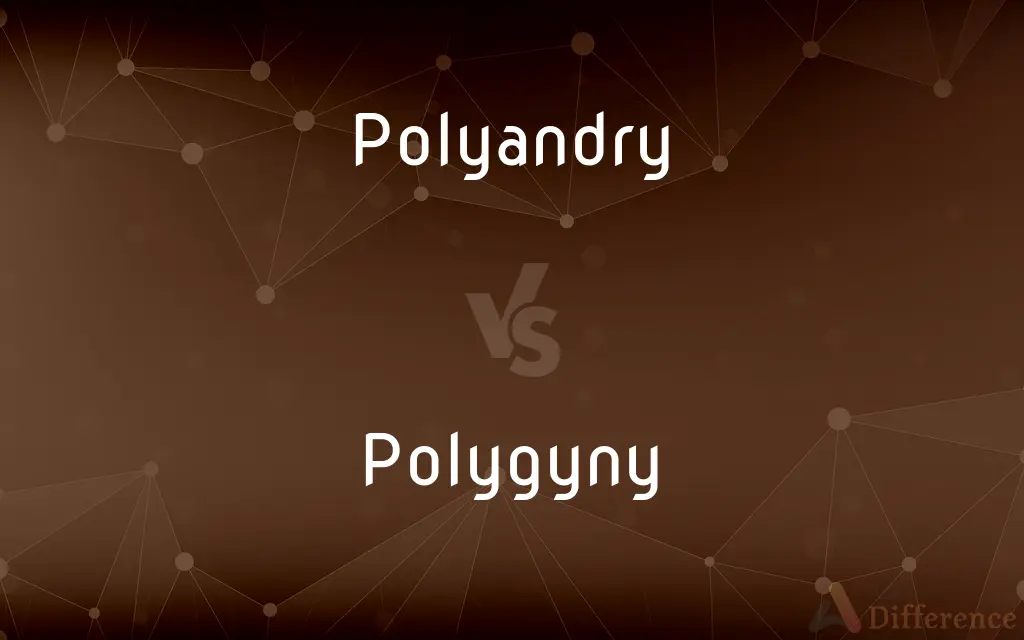Polyandry vs. Polygyny — What's the Difference?
Edited by Tayyaba Rehman — By Fiza Rafique — Updated on March 16, 2024
Polyandry involves a woman having multiple husbands, while polygyny refers to a man with multiple wives.

Difference Between Polyandry and Polygyny
Table of Contents
ADVERTISEMENT
Key Differences
Polyandry is a marital arrangement where a woman has several husbands at the same time. This practice is rare and often rooted in specific cultural or economic needs. Polygyny, on the other hand, involves a man being married to multiple women simultaneously. It is more common than polyandry and can be found in various cultures around the world, often tied to social, economic, and religious factors. Polygyny may be seen as a means to increase progeny and enhance familial labor forces, as well as a symbol of status and wealth for the man.
While polyandry is primarily concerned with ensuring the welfare and protection of a woman and her children by multiple partners, polygyny often focuses on expanding a man's lineage and securing economic or social advantages through multiple marriages. This difference highlights the varied approaches to familial and societal organization across cultures.
In polyandry, the husbands must negotiate their roles and responsibilities within the household, often leading to complex familial structures where cooperation and conflict resolution are vital. In contrast, polygyny typically involves a hierarchical structure where the husband holds a central authority, and the wives may have specific roles or statuses relative to one another.
The social implications of polyandry and polygyny extend beyond the family unit, influencing community dynamics, inheritance rules, and social status. Polyandry can challenge traditional gender roles and notions of paternity, whereas polygyny can reinforce patriarchal values and sometimes lead to competition and inequality among co-wives.
Comparison Chart
Definition
A marital practice where a woman has multiple husbands.
A marital practice where a man has multiple wives.
ADVERTISEMENT
Prevalence
Rare, specific to certain cultures.
More common, found in various cultures.
Social Implications
Challenges traditional gender roles, focuses on protection and resource allocation.
Often reinforces patriarchal structures, symbolizes status and wealth.
Familial Structure
Complex negotiations among husbands, cooperative approach.
Hierarchical, with the husband at the center and potential status among wives.
Economic & Social Factors
Often adopted in harsh environments or where men outnumber women.
Linked to expanding lineage, labor force, and displaying wealth or status.
Compare with Definitions
Polyandry
A marital system where a woman has multiple husbands.
In some Himalayan societies, polyandry is practiced to keep land in the family.
Polygyny
A marital arrangement where a man is married to several women.
Polygyny has been practiced in various cultures for centuries as a symbol of wealth.
Polyandry
Rare and often culturally specific.
Polyandry is rare and mostly observed in remote communities.
Polygyny
Often reflects social status and economic wealth.
Men in polygynous marriages often hold significant status within their communities.
Polyandry
Can challenge traditional gender norms.
Polyandry upends the usual marital dynamics by empowering a woman to have multiple husbands.
Polygyny
More common than polyandry and widely accepted in certain societies.
In some African societies, polygyny is a prevalent and culturally sanctioned practice.
Polyandry
Practiced mainly for economic and social stability.
Polyandry in certain cultures helps distribute the family's workload evenly among the husbands.
Polygyny
Can lead to hierarchical family structures.
In polygynous families, the first wife might have a higher status over other wives.
Polyandry
Focuses on collective support and survival.
Through polyandry, multiple men contribute to the welfare of a single family unit.
Polygyny
Tied to patriarchal values and fertility.
Polygyny is often associated with the desire to have a large progeny and maintain patriarchal lineage.
Polyandry
Polyandry (; from Greek: πολυ- poly-, "many" and ἀνήρ anēr, "man") is a form of polygamy in which a woman takes two or more husbands at the same time. Polyandry is contrasted with polygyny, involving one male and two or more females.
Polygyny
Polygyny (; from Neoclassical Greek πολυγυνία from πολύ- poly- "many", and γυνή gyne "woman" or "wife") is the most common and accepted form of polygamy, entailing the marriage of a man with several women.
Polyandry
Polygamy in which a woman has more than one husband.
Polygyny
Polygamy in which a man has more than one wife.
Polyandry
The condition or practice of having more than one husband at one time.
Polygyny
The condition or practice of having more than one wife at one time.
Polyandry
(Zoology) A mating pattern in which a female mates with more than one male in a single breeding season.
Polygyny
A mating pattern in which a male mates with more than one female in a single breeding season.
Polyandry
(Botany) The condition of having numerous stamens.
Polygyny
The condition of having more than one queen. Used of an insect colony.
Polyandry
The having of a plurality of husbands at the same time; usually, the marriage of a woman to more than one man, or the practice of having several husbands, at the same time.
Polygyny
The state or practice of having several wives at the same time; plurality of wives; marriage to several wives.
Polyandry
The possession by a woman of more than one husband at the same time; - contrasted with monandry.
Polygyny
The condition of an ant colony that has multiple egg-laying queens.
Polyandry
Having more than one husband at a time
Polygyny
The state or practice of having several wives at the same time; marriage to several wives.
Polygyny
Having more than one wife at a time
Common Curiosities
What is polyandry?
Polyandry is a marital practice where a woman has multiple husbands simultaneously.
What is polygyny?
Polygyny is a form of marriage where a man has multiple wives at the same time.
What are the social implications of polygyny?
Polygyny can reinforce patriarchal values, indicate social status, and sometimes lead to inequalities among wives.
How common is polyandry?
Polyandry is quite rare and practiced in a few specific cultures worldwide.
Is polygyny more common than polyandry?
Yes, polygyny is more common and widely accepted in various cultures compared to polyandry.
Does polyandry have economic advantages?
Polyandry can have economic advantages in certain contexts, such as evenly distributing labor and resources.
What cultural factors influence the acceptance of polygyny?
Cultural factors such as religion, tradition, and historical practices significantly influence the acceptance of polygyny.
What are the reasons for practicing polyandry?
Polyandry is often practiced for economic, environmental, or social reasons, such as resource allocation and maintaining family unity.
How do families function in a polyandrous system?
In polyandrous families, husbands must cooperate and negotiate their roles to support the family unit effectively.
Are there any legal restrictions on polyandry and polygyny?
Yes, many countries have legal restrictions or outright bans on both polyandry and polygyny.
What is the main difference between polyandry and polygyny?
The main difference is that polyandry involves a woman having multiple husbands, whereas polygyny involves a man having multiple wives.
Can polyandry challenge traditional gender roles?
Yes, polyandry can challenge and invert traditional gender norms by empowering a woman in marital dynamics.
Can polygyny affect women's rights and status?
Yes, polygyny can impact women's rights and status, often depending on the family's internal dynamics and societal norms.
Why is polygyny practiced?
Polygyny is often practiced for expanding lineage, economic benefits, and as a symbol of status and wealth.
How do children fit into polyandrous and polygynous family structures?
Children are raised collectively in both systems, though inheritance and lineage rules may vary significantly.
Share Your Discovery

Previous Comparison
Holder vs. Folder
Next Comparison
Insight vs. PerceptionAuthor Spotlight
Written by
Fiza RafiqueFiza Rafique is a skilled content writer at AskDifference.com, where she meticulously refines and enhances written pieces. Drawing from her vast editorial expertise, Fiza ensures clarity, accuracy, and precision in every article. Passionate about language, she continually seeks to elevate the quality of content for readers worldwide.
Edited by
Tayyaba RehmanTayyaba Rehman is a distinguished writer, currently serving as a primary contributor to askdifference.com. As a researcher in semantics and etymology, Tayyaba's passion for the complexity of languages and their distinctions has found a perfect home on the platform. Tayyaba delves into the intricacies of language, distinguishing between commonly confused words and phrases, thereby providing clarity for readers worldwide.












































